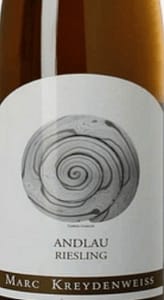Stavanger Vinforum was established in 1995 to contribute to more interest in and better understanding of wine in the southwestern region of Norway. Their most important activity is the annual fair, and this was the 23rd in a row. Each year has a specific theme, usually one or more countries. This year Spain and Portugal was in focus. 17 importers presented a total of around 250 wines, and there are always seminars: This time one mainly about Rueda by Igniacio Pariente of Bodegas Pariente (formerly II Victorias), one by Óscar Alegre (of Telmo Rodríguez’ company) about the northwestern corner.

Nils Nærland, member of the board and responsible for the program
I have written more about the fair itself for other publications. Here I will just present some of the highlights, from my own perspective and according to my own preferences.
Spanish sparkling wines: We are talking mainly about cava here. A head above the rest on the fair is Gramona, this time represented by their superb xarel.lo-based III Lustros Gran Reserva, now in the 2007 vintage. This wine shows the greatness of the xarel.lo grape, not very aromatic from the start, but after some years it starts to shine, and in Xavier Gramona’s opinion the best grape for cavas meant for ageing. This one spent 7 years on lees, has great depth and concentration, aromas of toast with a smoky note, and still with an incredible “presence” after all these years. Reserva Millesime Brut Nature 2011 (Castelo de Pedregosa), mainly from pinot noir, was kept for 3 years on the lees. It’s quite concentrated too, with the characteristic “bakery” aromas. Clos Lentiscus, DO Penedès (not Cava) was new to me. Their Blanc de Noirs Brut Nature 2010 was a different take. The “noir” variety of the title is sumoll, that not many years ago was a nearly extinct grape, but is now on the rise. The colour is almost orange, or maybe pink-ish, from a somewhat extended skin-contact. It’s more robust and tannic than the fair’s other sparklers.
To the white wines: Rueda is a region that is gaining still more ground in the conscousness of the people, but at the same time it’s facing problems with high production and many wines that are maybe correct, but with lack of personality and inspiration. I chose Basa 2015 (T. Rodríguez). It’s based on verdejo, but includes 10% of viura, and is sourced from various plots around the area. It’s a fresh, fruity wine for everyday drinking, and maybe a typical restaurant house wine. A very good one. Equally good and consistent is Gaba do Xil 2015, a Valdeorras wine from the same producer. Not so straightforwardly generous, but with more layers, and with those typical hints of straw and herbs from the godello grape.
 Óscar Alegre at importer Moestue Grape Selections’ table
Óscar Alegre at importer Moestue Grape Selections’ table
A single white wine represented the Canary Islands, Trenzado 2014 (Suertes del Marqués), a complex and rich skin-contact white that shows what can be done on Tenerife. This has been highlighted here.
From the Gredos area (province of Madrid) it was a nice to taste the Navaherreros Blanco from producer Bernabeleva again, now in the 2015 vintage. This is a predominantly albillo real with some macabeo, with hints of white flowers, peaches, yellow apples and slightly buttery too (from fermentation in big vats and ageing on the lees), with good body and a smooth texture.

Aina Mee Myhre of Heyday Wines presented a well-chosen range of wines
From Catalunya I first tasted Espelt Quinze Roures 2015 from Empordà near the French border. This is a barrel and lees-aged wine from the grapes with the Catalan names lledoner roig (grey garnacha) and lledoner blanc (white garnacha), grown in slate and sandy soils with understated aromas, quite complex (dried fruits, anise), good body and concentration, a touch of skin-contact, and just enough acidity to match. From Torroja, Priorat, producer Terroir al Límit was represented by 8 wines, 3 of them white. I especially liked the Terroir Històric 2015 (garnacha blanca 75%, macabeu 25%) aged in concrete eggs for 6 months, golden in colour with aromas of yellow apples, hints of honey, medium-bodied, and with a salty mineral aftertaste. The Terra da Cuques 2014 (pedro ximérez 80%, moscatel 20%) had more skin-contact feel, but was also fresher, with floral and citrusy notes, some herbs too. Quite rounded texture, expressive and with a touch of acidity. Dare I say elegant: For a Priorat very much so!
Fortified wines and dessert wines were not among my priorities this time. But some good wines for later in the meal were chosen. Among these the Molino Real, now in its 2010 incarnation. Telmo Rodríguez makes this wine in cooperation with Bodegas Almijara of Cómpeta, Málaga province. It’s always good, some vintages more lemony than others. I have a suspicion that it’s lighter than before, but it’s a really nice moscatel, an old-fashioned “mountain wine” introduced at a time when wines from the pedro ximénez grape was reigning supreme in the area. Lastly, I know very well the sherries offered, so I didn’t taste them this time. But I never miss a chance to taste the wines selected (not produced) by Equipo Navazos. They chose single “botas” (barrels) of wines that they find exceptional. The one presented here was 57 – La Bota de Florpower MMXII (in other words: a sherry vintage 2012), a light, grapey fino with some citrus notes, and yes! with a lot of “flor” character (the layer of yeast that covers the lightest wines in the bodega). Simply delicious!
On my way out I couldn’t miss a completely natural cider from the northern region Asturias, the Valdedios Natural (Manuel Bustos Amandi), with aromas of citrus, green apple, herbs, and with a slightly bitter aftertaste.


 Vicuña, eh… Well, here is one
Vicuña, eh… Well, here is one










